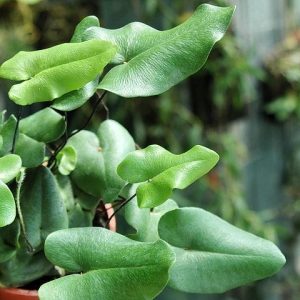Heart Fern

- Botanical Name: Hemionitis arifolia
- Family Name: Hemionitidaceae
- Stems: 6-10 Inches
- Temperature: 10°C - 24°C
- Other: Warm, moist places with indirect light ,well-draining soil
Overview
Product Description
The Ultimate Guide to Heart Fern Care and Appreciation
Origins and Description of Heart Fern
Heart Fern (scientific name: Hemionitis arifolia) is native to the tropical forests of Southeast Asia, including regions such as China, Vietnam, India, the Philippines, and Sri Lanka. This fern species is celebrated for its distinctive heart-shaped leaves, which are dark green, glossy on the top, and covered with fine hairs on the underside. The leaf blades can reach up to 25 centimeters (approximately 10 inches) in length and feature shapes that are arrow-like, heart-shaped, or finger-like in their lobes.

Heart Fern
Care and Habitat Preferences of Heart Fern
Heart Ferns thrive in warm and humid conditions, requiring indirect sunlight to avoid sunburn, and they favor soil that is moist yet well-draining. These ferns are at their best in climates with cool summers and do not tolerate hot and humid summers well. They are perfect for areas that mimic their natural habitat’s shade and consistent moisture, making them a popular choice for indoor gardening and landscapes where a tropical feel is desired.
Care Essentials
Heart Ferns thrive in warm, humid environments with indirect light. They’re ideal for bright spots near east or north-facing windows, free from direct sun exposure. Maintain a consistent moisture level in well-draining soil, and enhance the atmosphere with occasional mists or a humidifier to simulate their tropical origins. Feed your ferns with a balanced, water-soluble fertilizer during the growing season, and keep an eye out for pests or diseases that might affect their health. Regular trimming of old fronds encourages new growth and maintains a vibrant appearance.
Repotting and Long-term Care
For long-term care, repot your Heart Fern every 2 to 3 years, ideally in the spring, to provide fresh soil and a larger container if needed. This helps to ensure that the plant’s root system has ample space to grow. When selecting a pot, make sure it has drainage holes to prevent waterlogging. Heart Ferns can also be propagated through division or spore, allowing you to share these charming plants with other gardening enthusiasts. By following these simple care tips, your Heart Fern will reward you with its distinctive heart-shaped foliage and contribute a lush, tropical feel to your indoor space.
Soil and Water Requirements for Heart Fern
Heart Ferns are adaptable to soils with a pH ranging from acidic to neutral, with an optimal pH level between 5.0 and 7.0. These ferns have a significant need for ample moisture, thriving in soil that remains consistently damp but avoids waterlogged conditions. Their preference for moist environments makes them an excellent choice for garden spots with natural humidity or areas where consistent watering can be maintained.
Indoor and Outdoor Applications of Heart Fern
Heart Ferns are well-suited for both indoor cultivation and outdoor gardening in warmer climates. They serve as beautiful backdrops in flower beds, along borders, and within woodland gardens, providing a lush texture and a touch of greenery. Their compact size also makes them ideal for container gardening and as indoor plants, where they can bring a refreshing vitality and air-purifying qualities to interior spaces. These ferns are not only charming decorative elements but also contribute positively to the environment by enhancing air quality.










